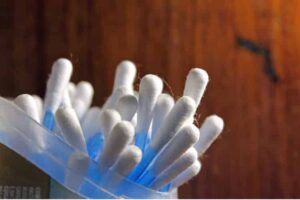After researching this topic (a popular request!), here’s what you need to know to make an informed decision about when and how to pierce your baby’s ears.
First, never pierce a baby’s ears before 3 months of age. Ideally, the procedure can be done around 5 to 6 months—but that depends on the baby.
What matters most is the size and thickness of the earlobes. Even at 6 months, if the lobes are too small or too close to the neck, the piercing may not be possible or safe. There needs to be enough space to prevent the post from irritating or injuring the skin.
This is why it’s essential to wait until the lobes are properly developed before proceeding.
Piercing too early can also affect the position of the hole as the ears grow, resulting in an off-centered or uneven appearance later on.
Who Can Pierce a Baby’s Ears?
Ear piercing is typically done by professionals—most often estheticians—who have completed both basic training and additional hours specifically focused on piercing babies’ ears.
Before proceeding, they carefully assess each ear: checking the size, thickness, and the space between the lobe and the neck. Since both ears can differ, each one is evaluated individually.
After the assessment, the esthetician selects an appropriate earring back, usually with a shorter post designed to minimize pressure on the baby’s delicate skin.
What to Expect and How Much It Costs
Piercing is often free when you purchase a pair of gold earrings, typically priced between $45 and $85. Choosing high-quality earrings helps prevent infections and other complications.
Some parents bring earrings received as gifts, but these are often too large or simply gold-plated—not ideal for a baby. They can be saved for later use.
Trained professionals will guide you through the procedure step by step and explain the aftercare. It’s also common to sign a liability waiver for legal protection.
Many use sterile, single-use devices that simplify the process—just make sure the equipment is up to date. You might be offered to pierce both ears at once, but this is rarely ideal. With the parent holding the baby securely, it’s usually safer to pierce one ear at a time.
Ear Piercing: Step-by-Step
Before the procedure:
Make sure your baby is well-fed and rested before the piercing. This helps reduce discomfort and crying afterward.
A qualified esthetician will usually apply Emla cream to numb the area, covering it for at least 45 minutes to ensure its effectiveness. Note that this cream isn’t suitable for babies under 3 months.
Estheticians often prefer applying it themselves to manage timing and ensure it’s done correctly. This also avoids issues if parents forget or apply it improperly, which can reduce its numbing effect.
Here are the stages for the procedure:
- When the baby’s lobes are frozen, the esthetician will help you place the baby on you so you can firmly hold it and avoid quick movements during the procedure.
- They may then disinfect each lobe and take the necessary measures before marking the site where they will pierce the lobes with a pencil.
- The piercing takes a fraction of a second using a sterile device. The baby may cry after piercing the first lobe, but you should quickly move on to the second before consoling her.
- If you breastfeed your baby, you can do so following the procedure to comfort and console her.
Aftercare and Final Thoughts
After the piercing, keep the earrings in place for at least three months, and avoid removing them completely for at least a year to maintain the hole.
Clean the area morning and night for 2 to 3 weeks, using a disinfectant. Watch for signs of infection: redness, warmth, or yellow-green discharge with or without an odor. If you’re unsure, consult a healthcare professional.
This article has covered the key points about piercing your baby’s ears—hopefully, it’s helped you feel more informed and reassured!
Marie Fortier
The Baby Expert





